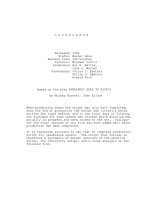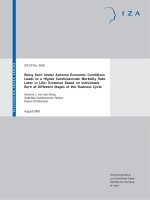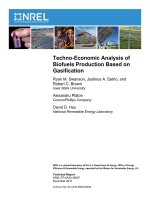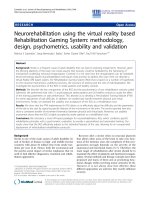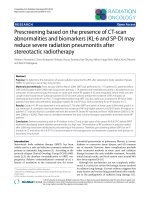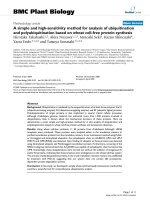Macromolecular architectures based on well defined poly(pentafluorostyrene) design, synthesis, characterization and applications
Bạn đang xem bản rút gọn của tài liệu. Xem và tải ngay bản đầy đủ của tài liệu tại đây (5.75 MB, 190 trang )
MACROMOLECULAR ARCHITECTURES BASED ON
WELL-DEFINED POLY(PENTAFLUOROSTYRENE):
DESIGN, SYNTHESIS, CHARACTERIZATION AND
APPLICATIONS
FU GUODONG
(
M. ENG. BUCT)
A THESIS SUBMITTED FOR THE DEGREE OF DOCTOR OF PHILOSOPHY
DEPARTMENT OF CHEMICAL &BIOMOLECULAR ENGINEERING
NATIONLA UNIVERSITY OF SINGAPORE
2005
ACKNOWLEDGEMENT
First of all, I would like to express my deepest gratitude to my supervisors, Professor
Kang En-Tang and Professor Neoh Koon-Gee, for the heartfelt guidance, invaluable
suggestions, profound discussion and encouragement throughout the period of this
research work. Their enthusiasm, sincerity and dedication to scientific research have
greatly impressed me and will benefit me in my future career.
I would like to thank all my colleagues and the laboratory officers of the Department
of Chemical and Biomolecular Engineering for their kind help and assistance. In
particular, thanks are due to Dr. Lin Qidan, Dr. Cheng Zhenping, Dr. Wang Wencai
and Mr. Cai Qinjia for their helpful advice and discussion. It is my great pleasure to
work with all of them. I am also indebted to Dr. Chen Lingfeng for the material
characterization. The research scholarship provided by National University of
Singapore is also gratefully acknowledged.
Finally, I would like to express my deepest gratitude and indebtedness to my wife, my
parents, my daughter, my sister and brother for their love and support.
I
TABLE OF CONTENTS
Acknowledgement I
Table of Contents II
Summary V
Nomenclature VIII
Lists of Figures X
List of Tables XVI
Chapter 1 Introduction 1
Chapter 2 Literature Review 9
2.1 Applications and Physicochemical Properties of Fluoropolymers 10
2.2. Macromolecular Architectures, Design and Synthesis
11
2.2.1 Macromolecular Architectures via ATRP 12
2.2.2 Functional Copolymers Prepared via ATRP 15
2.2.3 Fluoro-Block Copolymers Prepared via ATRP 16
2.3 Ultra-Low-κ Materials 19
2.3.1 Preparation of Fluoropolymer-based Dielectrics 19
2.3.2 Nanoporous Low-κ Materials 20
2.4 Amphiphilic Block Copolymers 23
2.4.1 Application of Amphiphilic Block Copolymers as Emulsifiers 24
2.4.2 Application of Amphiphilic Block Copolymers in Drug Delivery 25
2.4.3 Application of Amphiphilic Block Copolymers in Structure-controlled
Nanomaterials 26
II
Chapter 3 Comb-Shaped Macromolecules of Rigid Fluorinated Polyimides with
Polystyrene/Poly(pentafluorostyrene) Brushes Prepared by ATRP and Their
Application as Ultra-Low Dielectric Constant Materials
3.1 Introduction 30
3.2 Experimental 31
3.3 Results and Discussion 38
3.4 Conclusions 57
Chapter 4 Nanoporous Ultra-Low Dielectric Constant Fluoropolymer Films via
Selective UV Decomposition of Poly(pentafluorostyrene-block-
methylmethacrylate) Copolymers Prepared by ATRP
4.1 Introduction 59
4.2 Experimental 60
4.3 Results and Discussion 64
4.4 Conclusions 83
Chapter 5 Nanoporous Ultra-Low-κ Fluoropolymer Films from Agglomerated
and Crosslinked Hollow Nanospheres of
Poly(pentafluorostyrene)-block-Poly(divinyl benzne)
5.1 Introduction 85
5.2 Experimental 88
5.3 Results and Discussion 90
5.4 Conclusions 100
III
Chapter 6 Three-Dimensionally-ordered Porous Membrane from the
Self-Assembly and Reverse Micelle formation of Amphiphilic
Poly(pentafluorostyrene-block-acrylic acid) Block Copolymer Prepared by ATRP
6.1 Introduction 102
6.2 Experimental 104
6.3 Results and Discussion 108
6.4 Conclusions 120
Chapter 7 Tadpole-shaped Amphiphilic Block-Graft Poly(pentafluorostyrene)
-block-(poly(glycidyl methacrylate)-graft-poly(acrylic acid)) Prepared
Copolymers via Consecutive Atom Transfer Radical Polymerizations and Their
Micelle Formation
7.1 Introduction 122
7.2 Experimental 124
7.3 Results and Discussion 130
7.4 Conclusions 149
Chapter 8 Conclusions and Recommendations for Future work 150
References 155
List of Publications 170
IV
Summary
Fluoropolymers are potential candidates for dielectric interlayer because of their good
chemical and thermal stability, and the lowest dielectric constants (κ’s) among the
bulk polymers. However, their applications in sub-micron and nano-level electronics
are hindered by difficulties in processing. Amphiphilic fluoropolymers with
well-defined molecular weight, controllable chemical component, and various
molecular structures are of great interest because of their unique solution and
associative properties. The aims of this thesis were to prepare well-defined
fluoropolymers and copolymers with favorable solution properties, as well as to
prepare ultra-low-κ (<2.0) nano-structured fluoropolymer films via introducing
nanopores into the polymer matrix.
First of all, comb-shaped copolymers consisting of rigid fluorinated polyimide (FPI)
backbone and flexible polystyrene (PS) brushes (FPI-cb-PS), or
poly(pentafluorostyrene) (PFS) brushes (FPI-cb-PFS), were synthesized by atom
transfer radical polymerization (ATRP) from the bromide-containing FPI
macroinitiators (FPI-Br). In addition to having a dielectric constant as low as 2.1, the
resulting comb-shaped FPI-cb-PFS copolymer also exhibited good processability,
good thermal stability (470
o
C) and good mechanical properties. The FPI-cb-PFS
copolymer is thus a potential ultra-low-κ material for sub-micron and nano-level
electronics.
Nanoporous fluoropolymer films were also prepared via selective UV decomposition
of the PMMA blocks in the well-defined PFS-b-PMMA copolymers prepared via
ATRP. The nanoporous fluoropolymer films with pore size in range of 30-50 nm and
V
porosity in range of 15-40% were obtained from the PFS-b-PMMA copolymers of
different PMMA contents. Dielectric constants approaching 1.8 were achieved in the
nanoporous fluoropolymer films having almost completely decomposed PMMA
blocks.
Consecutive surface-initiated ATRPs of pentafluorostyrene and divinyl benzene from
silane-functionalized SiO
2
nanopartilces gave rise to core-shell structured
silica-graft-poly(pentafluorostyrene)-block-poly(divinyl benzene)
(SiO
2
-g-PFS-b-PDVB) nanospheres. SiO
2
-g-PFS-b-PDVB (SiO
2
core and polymer
shell) nanospheres of about 80-150 nm in diameter were allowed to agglomerate on a
silicon substrate to form a film of about 3 µm in thickness. Under UV irradiation, the
PDVB outer layer with residual double bonds on the core-shell nanospheres
underwent inter- and further intra-sphere crosslinking to strengthen the film. Removal
of the silica cores of the crosslinked nanospheres by HF etching gave rise to the
nanoporous fluoropolymer film. The high porosity contributed by both the interstitial
spaces among the nanoshpheres and the hollow cores of the nanospheres led to a
dielectric constant as low as 1.7 for the resulting film.
Block copolymers of PFS and poly(tert-butyl acrylate) (PtBA),or PFS-b-PtBA
copolymers, were synthesized via consecutive ATRP’s. Amphiphilic block
copolymers of PFS and poly(acrylic acid) (PFS-b-PAAC copolymers) were prepared
via hydrolysis of the corresponding PFS-b-PtBA copolymers. The amphiphilic
PFS-b-PAAC copolymers were cast into porous membranes by phase inversion in
aqueous media. Membranes with well-defined pores of sizes in the micrometer range
VI
were obtained as a result of inverse micelle formation. The pH of the aqueous media
for phase inversion and the PAAC content in the PFS-b-PAAC copolymers could be
used to adjust the pore size of the membranes.
Finally, tadpole-shaped (or rod-coil) block-graft copolymers, consisting of a PFS
block and a glycidyl methyacrylate polymer (PGMA) block with grafted PtBA side
chains, or PFS-b-(PGMA-g-PtBA) copolymers, were synthesized by consecutive
ATRP’s. Hydrolysis of the PtBA side chains in the block-graft copolymer into the
PAAC side chains gave rise to an amphiphilic PFS-b-(PGMA-g-PAAC)
macromolecule with a brush-shaped hydrophilic head (rod) and a hydrophobic tail
(coil). The formation of well-defined and uniform micelles from the present
well-defined block-graft copolymers was also demonstrated.
VII
NOMENCLATURE
AAc
NMP
Acrylic acid
N-Methyl-2-pyrrolidone
AFM
NMR
Atomic force microscopy
ATRP
Atom transfer radical polymerization
-b-
-block-
BE
Binding energy
BET
Brunauer-Emmett-Teller
BMPA
2-Bromo-2-methyl propionic acid
bpy
2,2’-Bipirine
CuBr
Copper bromide(I)
DSC
Differential scanning calorimetry
DVB
Divinyl benzene
EBB
Ethyl bromoisobutyrate
FESEM
Field emission scanning electron microscopy
FS
2,3,4,5,6-Pentafluorostyrene
-g-
-graft-
GMA
Glycidyl methacrylate
GPC
Gel permeation chromatography
MMA
Methyl methacrylate
M
n
Number average molecular weight
Nuclear magnetic resonance
VIII
IX
PAAC Poly(acrylic acid)
PDI Polydispersity index
PFS Poly(pentafluorostyrene)
PFS-Br PFS macroinitiators (with an alkyl halide chain end)
PGMA Poly(glycidyl methacrylate)
PMDETA N,N,N’,N’,N’’-Pentamethyldiethlyenetriamine
PMMA Poly(methyl methacrylate)
PS Poly(styrene)
PtBA Poly(tert-butyl acrylate)
SEM Scanning electron microscopy
tBA tert-Butyl acrylate
TBAH Tetrabutylammonium hydroxide
TGA Thermogravimetric analyses
THF Tetrahydrofuran
ToF-SIMS
Time-of-flight secondary ion mass spectrometry
UV Ultraviolet
XPS X-ray photoelectron spectroscopy
X
LIST OF FIGURES
Figure 3.1.
Schematic illustration of the synthesis of comb-shaped copolymer of
fluorinated polyimide and polystyrene (FPI-cb-PS) and of
fluorinated polyimide and polypentafluorostyrene (FPI-cb-PFS)
copolymer by atom radical polymerization (ATRP)
Figure 3.2.
Gel permeation chromatography (GPC) traces of the (a)
brom-contained fluorinated polyimide macroinitiator (FPI-Br), (b)
comb-shaped copolymer of fluorinated polyimide and polystyrene
(FPI-cb-PS2 in Table 3.1. Synthetic conditions:
[Styrene]:[Br]
FPI-Br
:[CuBr]:[PMDE] = 200:1:1:1 at 110
o
C for 4 h)
comb-shaped copolymer, and (b) polystyrene (PS) side chains
hydrolyzed from FPI-cb-PS2.
Figure 3.3.
300 MHz
1
H NMR spectra of the (a) brom-contained fluorinated
polyimide macroinitiator (FPI-Br) having a M
n
of about 9.4x10
3
g/mole, (b) comb-shaped copolymer of fluorinated polyimide and
polystyrene (FPI-cb-PS2 in Table 3.1.
[Styrene]:[Br]
FPI-Br
:[CuBr]:[PMDE] = 200:1:1:1 at 110
o
C for 4 h)
having a M
n
of about 1.4x10
5
g/mole (c) comb-shaped copolymer of
fluorinated polyimide and polypentafluorostyrene (FPI-cb-PFS2 in
Table 3.1. [PF]:[Br]
FPI-Br
:[CuBr]:[PMDE] = 200:1:1:1 at 110
o
C for 4
h) copolymer having a M
n
of about 1.6x10
5
g/mole.
Figure 3.4
C 1s and Br 3d core-level spectraof the (a) brom-contained
fluorinated polyimide macroinitiator (FPI-Br) having a M
n
of about
9.4x10
3
g/mole, (b) comb-shaped copolymer of fluorinated
polyimide and polystyrene (FPI-cb-PS2 in Table 3.1.
[Styrene]:[Br]
FPI-Br
:[CuBr]:[PMDE] = 200:1:1:1 at 110
o
C for 4 h)
having a M
n
of about 1.4x10
5
g/mole (c) comb-shaped copolymer of
fluorinated polyimide and polypentafluorostyrene (FPI-cb-PFS2 in
Table 31. [PF]:[Br]
FPI-Br
:[CuBr]:[PMDE] = 200:1:1:1 at 110
o
C for 4
h) copolymer having a M
n
of about 1.6x10
5
g/mole.
Figure 3.5
(a) AFM images of the comb-shaped comb-shaped copolymer of
fluorinated polyimide and polystyrene (FPI-cb-PS2 in Table 3.1.
[Styrene]:[Br]
FPI-Br
:[CuBr]:[PMDE] = 200:1:1:1 at 110
o
C for 4 h)
XI
macromolecular assembly on the hydrogen-terminated Si(100). The
overall size of the image is approximately 500 nm x 500 nm. The
topographical roughness of the surface with self-assembled
macromolecular arrays is also shown. (b) A comb-shaped
comb-shaped copolymer of fluorinated polyimide and polystyrene
(FPI-cb-PS) model with 4 imide repeat units and two PS chains each
having 4 repeat units.
Figure 3.6.
Thermal gravimetric (TGA) curves of (a) brom-contained
fluorinated polyimide macroinitiator (FPI-Br) having a M
n
of
9.4x10
3
g/mol, (b) comb-shaped copolymer of fluorinated
polyimide and polystyrene (FPI-cb-PS2 in Table 3.1.
[Styrene]:[Br]
FPI-Br
:[CuBr]:[PMDE] = 200:1:1:1 at 110
o
C for 4 h)
having a M
n
of about 1.4x10
5
g/mole, and (c) comb-shaped
copolymer of fluorinated polyimide and polypentafluorostyrene
(FPI-cb-PFS2 in Table 3.1. [PF]:[Br]
FPI-Br
:[CuBr]:[PMDE] =
200:1:1:1 at 110
o
C for 4 h) copolymer having a M
n
of about 1.6x10
5
g/mole.
Figure 4.1.
Schematic illustration of the synthesis of the
poly(pentafluorostyrene)-graft-poly(methyl methacrylate) copolymer
from ATRP and the preparation of the corresponding nanoporous
poly(pentafluorostyrene) film.
Figure 4.2.
300 MHz
1
H NMR spectra of (a) the poly(pentafluorostyrene) with a
M
n
of 5.2x10
4
g/mol (PFS4 in Table 4.1), and (b) the corresponding
poly(pentafluorostyrene)-graft-poly(methyl methacrylate) block
copolymer with a M
n
of 7.3x10
4
g/mol (PFS-b-MMA2 in Table 4.1)
Figure 4.3
C 1s core-level spectra of (a) the pristine poly(pentafluorostyrene)
(PFS) film with a M
n
of 5.2x10
4
g/mol (PFS4 in Table 4.1), (b) the
poly(pentafluorostyrene)-graft-poly(methyl methacrylate) block
copolymer with a M
n
of 7.3x10
4
g/mol (PFS-b-MMA2 in Table 4.1),
and (c) the nanoporous PFS film prepared from the PFS-b-PMMA2
copolymer film.
Figure 4.4.
TGA curves of (a) the pristine poly(pentafluorostyrene) PFS with a
M
n
of 5.2x10
4
g/mol (PFS4 in Table 4.1), (b) the
poly(pentafluorostyrene)-graft-poly(methyl methacrylate) block
XII
copolymer film with a M
n
of 7.3x10
4
g/mol (PFS-b-PMMA2 in
Table 4.1), and (c) the nanoporous poly(pentafluorostyrene) (PFS)
film prepared from the PFS-b-PMMA2 copolymer film.
Figure 4.5(a).
Positive ion ToF-SIMS spectra of the
poly(pentafluorostyrene)-graft-poly(methyl methacrylate) block
copolymer with a M
n
of 7.3x10
4
g/mol (PFS-b-PMMA2 in Table
4.1)
Figure 4.5(b)
The nanoporous poly(pentafluorostyrene) (PFS) film prepared from
the poly(pentafluorostyrene)-graft-poly(methyl methacrylate)
(PFS-b-PMMA2 in Table 4.1) copolymer film after selective UV
decomposition of the poly(methyl methacrylate) (PMMA) block.
Figure 4.6
FESEM cross-sectional images of the the
poly(pentafluorostyrene)-graft-poly(methyl methacrylate) copolymer
film with a M
n
of 7.3x10
4
g/mol (PFS-b-PMMA2 in Table 4.1) (a)
before (b) after UV decomposition of the PMMA blocks.
Figure 4.7.
FESEM surface images of the PFS-b-PMMA copolymer film with a
M
n
of 7.3x10
4
g/mol (PFS-b-PMMA2 in Table 4.1) (a) before (b)
after UV decomposition of the poly(methyl methacrylate) (PMMA)
blocks.
Figure 4.8.
Dielectric constant of the nanoporous poly(pentafluorostyrene)
(PFS) film as a function of pore volume of the film.
Figure 5.1.
Schematic illustration of the process for preparing crosslinked
ultra-low-κ fluoropolymer films from agglomeration of the
nanospheres of poly(pentafluorostyrene)-block-poly(divinyl
benzene)
Figure 5.2
(a) TEM image of the initiator-immobilized silica particles, (b)TEM
image of the silica-graft-poly(pentafluorostyrene) (SiO
2
-g-PFS1 in
Table 5.1) nanospheres, (b’) FESEM image of the ruptured
poly(pentafluorostyrene) (PFS) hollow spheres, (c)FESEM
cross-sectional image of a composite film fabricated from
XIII
agglomerated silica-graft-poly(pentafluorostyrene)-block
-poly(divinyl benzene) (SiO
2
-g-PFS-b-PDVB1 in Table 5.2)
nanospheres, and (d) FESEM cross-sectional image of the
corresponding crosslinked nanoporous fluoropolymer film.
Figure 5.3.
XPS wide scan spectra of the (a) initiator-immobilized silica
particles, (b) silica-graft-poly(pentafluorostyrene) (SiO
2
-g-PFS3 in
Table 5.1) nanospheres, and (c)
silica-graft-poly(pentafluorostyrene)-block-poly(divinyl benzene)
(SiO
2
-g-PS-b-PDVB3 in Table 5.2) nanospheres.
Figure 5.4.
EDX spectra of the (a) silica-graft-poly(pentafluorostyrene)
nanoparticles (SiO
2
-g-PFS 1 in Table 5.1), (b)
poly(pentafluorostyrene) hollow nanospheres, (c)
silica-graft-poly(pentafluorostyrene)-block-poly(divinyl benzene)
(SiO
2
-g-PFS-b-PDVB3 in Table 5.2) nanospheres, and (d)
crosslinked nanoporous poly(pentafluorostyrene) (PFS) films
prepared from SiO
2
-g-PFS-b-PDVB3 in Table 5.2.
Figure 6.1.
Schematic illustration of the formation of reverse micelle and porous
membrane from the amphiphilic
poly(pentafluorostyrene)-block-poly(acrylic acid) (PFS-b-PAAC )
block copolymer.
Figure 6.2
300 MHz
1
H NMR spectra of (a) the
poly(pentafluorostyrene)-block-poly(tert-butyl acrylate)
(PFS-b-PtBA) copolymer with a M
n
of 7.3x10
4
g/mol (PFS-b-PtBA1
in Table 6.1), and (b) the corresponding
poly(pentafluorostyrene)-block-poly(acrylic acid) (PFS-b-PAAC)
block copolymer from hydrolysis of the PFS-b-PtBA1 copolymer.
Figure 6.3
C 1s core-level spectra of (a) the
poly(pentafluorostyrene)-block-poly(tert-butyl acrylate) copolymer
with a M
n
of 7.3x10
4
g/mol (PFS-b-PtBA1 in Table 6.1), and (b) the
corresponding poly(pentafluorostyrene)-block-poly(acrylic acid)
(PFS-b-PAAC) block copolymer hydrolyzed from the PFS-b-PtBA1
copolymer.
XIV
Figure 6.4.
SEM images of (a) surface view of the
poly(pentafluorostyrene)-block-poly(acrylic acid) (PFS-b-PAAC)
copolymer membrane hydrolyzed from
poly(pentafluorostyrene)-block-poly(tert-butyl acrylate)
(PFS-b-PtBA1 in Table 6.1) copolymer, (b) cross-sectional view of
the PFS-b-PAAC copolymer membrane hydrolyzed from
PFS-b-PtBA1 in Table 6.1.
Figure 6.5.
SEM images of (a) surface view of the
poly(pentafluorostyrene)-block-poly(acrylic acid) (PFS-b-AAC)
copolymer membrane hydrolyzed from
poly(pentafluorostyrene)-block-poly(tert-butyl acrylate)
(PFS-b-PtBA3 in Table 6.1) copolymer and (b) surface view of the
PFS-b-AAC copolymer membrane hydrolyzed from PFS-b-PtBA1 in
Table 6.1 and cast in an aqueous medium at the PH of 2.
Figure 7.1
Consecutive atom transfer radical polymerizations (ATRP’s) for the
preparation of the block-graft amphiphlic macromolecule of
poly(pentafluorostyrene)-block-(poly(glycidyl methacrylate)-graft-
poly(acrylic acid)) (PFS-b-(PGMA-g-PAAC)).
Figure 7.2
300 MHz
1
H NMR spectra of (a) the poly(pentafluorostyrene)
–block-poly(glycidyl methacrylate) (PFS-b-PGMA) copolymer with
a M
n
of 2.9x10
4
g/mol (PFS-b-PGMA1 in Table 7.1), (b) the
corresponding macroinitaitor with a M
n
of 3.0x10
4
g/mol
(Macroinitator1 in Table 7.2)
Figure 7.3
GPC traces of the (a) the pristine poly(pentafluorostyrene) (PFS)
homopolymer (PFS in Table 7.1), (b) the
poly(pentafluorostyrene)-block-poly(glycidyl methacrylate)
copolymer (PFS-b-PGMA1 copolymer in Table 7.1), (c) the
corresponding Macroinitiator1 in Table 7.2, (d) the
poly(pentafluorostyrene)-block- (poly(glycidylmethacrylate)-graft-
poly(tert-butylacrylate)) copolymer (PFS-b-(PGMA-g-PtBA)1 in
Table 7.3), and (e) the corresponding amphiphilic
poly(pentafluorostyrene)-block-(poly(glycidyl methacrylate)-graft-
poly(acrylic acid)) (PFS-b-(PGMA-g-PAAC)) copolymer
hydrolyzed from PFS-b-(PGMA-g-PtBA)1
XV
Figure 7.4
C 1s core-level spectra of (a) the PFS-b-PGMA1 copolymer in Table
7.1, (b) the corresponding macroinitaitor Macroinitator1 in Table
7.2, (c) the PFS-b-(PGMA-g-PtBA)1 block-graft copolymer in Table
7.3, and (d) the corresponding amphiphilic PFS-b-(PGMA-g-PAAC)
copolymer hydrolyzed from PFS-b-(PGMA-g-PtBA)1
Figure 7.5
300 MHz
1
H NMR spectra of (a) the poly(pentafluorostyrene)
-block-(poly(glycidyl methacrylate)-graft-poly(tert-butylacrylate))
(PFS-b-(PGMA-g-PtBA)) copolymer with a M
n
of 6.6x10
4
g/mol
(PFS-b-(PGMA-g-PtBA)1 in Table 7.3), and (b) the corresponding
amphiphilic poly(pentafluorostyrene)-block-(poly(glycidyl
methacrylate)-graft-poly(acrylic acid)) PFS-b-(PGMA-g-PAAC)
copolymer hydrolyzed from PFS-b-(PGMA-g-PtBA)1.
Figure 7.6
(a) AFM image of the rod-coil poly(pentafluorostyrene)
-block-(poly(glycidyl methacrylate)-graft-poly(acrylic acid))
(PFS-b-(PGMA-g-PAAC)) (hydrolyzed from
PFS-b-(PGMA-g-PtBA)2 in Table 7.3) copolymer assembly on the
oxides-covered Si(100) surface. The overall size of the image is
approximately 1 µm x 1 µm, and (b) the plausible macromolecular
structure of the poly(pentafluorostyrene)-block-(poly(glycidyl
methacrylate)-graft- poly(acrylic acid)) (PFS-b-(PGMA-g-PAAC))
copolymer on the Si(100) surface.
Figure 7.7
(a) FESEM image of the micelles from 1 g/L solution of the
poly(pentafluorostyrene)-block-(poly(glycidyl methacrylate)-graft-
poly(acrylic acid)) copolymer (PFS-b-(PGMA-g-PAAC)2 in Table
7.3), and (b) the plausible mechanism of micelle formation from
block copolymer.
Scheme 4.1
Assignments of Positive Ions in ToF-SIMS
XVI
LIST OF TABLES
Table 3.1
Characterization of the Fluorinated Polyimide and
Polystyrene/Pentafluorostyrene Copolymers
Table 4.1
Characteristics of the Poly(pentafluorostyrene) and
Poly(pentafluorostyren-b-methyl methacrylate) Copolymers
Table 5.1
Characteristics of the SiO
2
-graft-Poly(pentafluorostyrene)
Nanospheres
Table 5.2
Characteristics of the SiO
2
-graft-Poly(pentafluorostyrene)-
block-Poly(divinyl benzene) Nanospheres and the Resulting
Nanoporous Films
Table 6.1.
Characteristics of the Poly(pentafluorostyrene) and
Poly(pentafluorstyren-b-tert butyl acrylate) Copolymers and the
Resulting Porous Membranes.
Table 7.1
Preparation of Poly(pentafluorostyrene) (PFS) and
Poly(pentafluorostyrene)-block-poly(glycidyl methacrylate)
(PFS-b-PGMA) Block Copolymers by Atom Transfer Radical
Polymerization (ATRP).
Table 7.2
Immobilization the Atom Transfer Radical Polymerization
(ATRP) Initiator on the
Poly(pentafluorostyrene)-block-poly(glycidyl methacrylate)
(PFS-b-PGMA) Copolymers.
Table 7.3
Characterization of Poly(pentafluorostyrene)-block-(poly(glycidyl
methacrylate)-graft-poly(tert-butylacrylate))
(PFS-b-(PGMA-g-PtBA)) and
Poly(pentafluorostyrene)-block-(poly(glycidyl methacrylate)
-graft-poly(acrylic acid)) (PFS-b-(PGMA-g-PAAC)) Copolymers.
XVII
CHAPTER 1
INTRODUCTION
1
Fluorolymers possess many desirable chemical and physical properties such as high
thermal stability, enhanced chemical, resistance to aging and weather resistance, oil
and water repellency, chemical inertness and low flammability and refractive index.
Arising from these special physicochemical properties, fluoropolymers, as a family
of high-performance material, are widely used in aerospace, aeronautics, optics,
microelectronics, paints and coatings, and engineering structures and as
biomaterials.
Polymeric architectures based on fluoromonomers, and complex molecular
structures, such as diblock copolymer, triblock copolymers, comb-shaped
copolymers, tadpole-shaped copolymers, dumbbell-shaped and hyperbranched
copolymers, possess the unique physicochemical properties of the fluoropolymer
segment such as high temperature resistance, excellent chemical inertness and low
surface energy, and those of the other functional polymers segment such as good
biocomparability and environment sensitivities . They are expected to exhibit unique
properties in solution and solid state. Thus, fluorinated copolymers are potentially
useful as biomedical and dielectric materials. Fluorinated copolymers, for example,
can be used to prepare dielectric interlayers because of their low dielectric constants,
chemical inertness and good thermal stability.
Ultra-low dielectric constant interlayers are required to reduce the
resistance-capacitance time delay, cross-talk, and power dissipation in the new
2
generation of high density integrated circuits. According to the SIA (Semiconductor
Industry Association) roadmap, interlayers with a dielectric constant of less than 2.5
are required for use in the new generation of integrated circuits, and of less than 2.0
for the future’s [Maier, 2001]. Among all the bulk polymeric materials,
fluoropolymers, such as polytetrafluoroethylene, have the lowest dielectric constant
of about 2.0-2.2. However, the difficulties in processing these fluoropolymers
hindered their application in sub-micrometer- and nanometer-scale electronics. Thus,
the synthesis of fluorinated block copolymers with good thermal property, low-κ
value, high molecular weight, as well as good processability (good solubility in
common organic solvent) is of great interest.
Attempts have been made to reduce the dielectric constant of materials to less than
2.0 [Maier et al., 2001]. Among the efforts, introduction of air gaps and nanopores
into polymer films has received much attention. The incorporation of air, which has
a dielectric constant of about 1, can greatly reduce the dielectric constant of the
resulting porous structure. Since the bulk flouropolymers have the lowest dielectric
constant in the organic polymeric materials, introduction of nanopores into
fluroropolymers would reduce their dielectric constants down to 2.0 or below. [see
Chapter 2]
Amphiphilic polymer architectures is expected to exhibit special solution properties
and micelle formation arising from the immiscibility between highly hydrophobic
3
block and hydrophilic block, as well as competing thermodynamic effects. Micelles
fabricated from self-assembly of amphiphilic block copolymers could be used as
nanoreservoirs in controlled drug delivery, gene therapy and phase transfer catalysis
[Riess, 2003], and as templates for the fabrication of nanostructured hybrids [Neiser
et al., 2004]. Micelle formation involving the amphiphilic copolymer was governed
not only by the components of copolymers, but also by the molecular structure of
the copolymers. Thus, the synthesis of amphiphilic block copolymers with
well-defined molecular weights and the study of the micelle formation in these
materials will be of great interest.
The fluoropolymers and copolymers with well-controlled molecular weight and
structures can be synthesized by anionic and cationic process [Imae, 2003].
However, the stringent reaction conditions have limited the wide-spread application
of these methods in industry. Recent development in control living radical
polymerization, especially in atom transfer radical polymerization (ATRP), has
provided a powerful tool for synthesizing well-defined polymers [Patten et al., 1998;
Matyjaszewski et al., 2001]. Most importantly, the tolerance for functional groups
and impurity makes ATRP a versatile tool for synthesizing complex polymeric
architectures. Complex polymeric architectures with varying compositions,
functionalities and topologies could be prepared by ATRP [see Chapter 2]. Some
fluoropolymer architectures, such as di-block, tri-block and star block copolymer
have been prepared by ATRP [Chapter 2].
4
Even though some fluorinated block copolymers have been prepared via ATRP and
the physical and chemical properties of these copolymers have been studied, little
research has been done on the synthesis and physicochemical properties of the
amphiphilic fluorinated block copolymers with well-defined structure and
architectures. Furthermore, little work has been carried out to prepare fluorinated
block copolymers with low dielectric constant, high molecular weight, good thermal
property and good processability, as well as nanoporous ultra-low-κ fluoropolymer
films with well-defined and controllable pore sizes.
The overall purpose of this thesis is to synthesize of fluoropolymer with various
macromolecular structures, including diblock, comb-shaped and tadpole shape
copolymers via ATRP’s. In addition, the objectives of this thesis include:
(i) to prepare fluorinated copolymers with low-κ value, good processability,
improved mechanical property and good thermal stability.
(ii) to prepare nanoporous ultra-low-κ fluoropolymer film with well-defined pore
size
(iii) to prepare three-dimensionally-ordered porous fluoropolymer membrane
from self-assembly and reverse micelle formation of diblock amphiphilic
fluoropolymer.
(iv) to study molecular structure and micelle formation of amphiphilic
tadpole-shaped fluoropolymer
5
The Chapter 2 presents an overview of the related literatures. In Chapter 3,
comb-shaped copolymers, consisting of fluorinated polyimide (FPI) backbones and
polystyrene (PS) or poly(pentafluorostyrene) (PFS) brushes, were synthesized by atom
transfer radical polymerization from the FPI macroinitiators. The PS and PFS side
chains in the comb-shaped copolymers were of well-defined length. The chain length
of the PS and PFS side chains could be regulated by varying the ATRP time. The
FPI-cb-PS copolymer macromolecules were shown to self-assemble into ordered
arrays on the hydrogen-terminated silicon surface. The macromolecular assembly,
consisting of aligned and uniformly spaced rigid rods of 20-30 nm in length, was
revealed by AFM images. In addition to good solution processability, the FPI-cb-PFS
copolymer with its unique macromolecular architecture and high molecular weight up
to 3,600,000 also exhibited good thermal stability, improved mechanical property and
very low dielectric constant (κ~2.1). These fluoropolymers are thus a potential
ultra-low-κ material for sub-micron and nano-level electronics.
In Chapter 4 block copolymers of PFS and poly(methylmethacrylate) (PMMA)
(PFS-b-PMMA), were synthesized by ATRP. The copolymers were cast into thin
films, followed by UV irradiation to photo-degrade the PMMA block. The porosity
of the PFS film can be regulated by changing the PMMA content of the
PFS-b-PMMA copolymer. A dielectric constant of 1.8 can be achieved in the
nanoporous PFS film with a pore volume above 0.3 ml/g.
6
In Chapter 5, core-shell structured poly(pentafluorostyrene)-block-poly(divinyl
benzene) (SiO
2
-g-PFS-b-PDVB) nanospheres were prepared via consecutive
surface-initiated ATRPs of pentafluorostyrene and divinyl benzene on SiO
2
nanopartilces. SiO
2
-g-PFS-b-PDVB nanospheres of about 80-150 nm in diameter
were allowed to agglomerate on a silicon substrate to form a film of about 2-4 µm in
thickness. Under UV irradiation, PDVB outer layer with residual double bonds on
the core-shell nanospheres underwent inter- and further intra-sphere crosslinking to
strengthen the film. Removal of the silica cores of the crosslinked nanospheres by
HF etching gave rise to the nanoporous fluoropolymer film. The high porosity
contributed by both the interstitial spaces among the nanoshpheres and the hollow
cores of the nanospheres led to a dielectric constant as low as 1.7 for the resulting
film.
In Chapter 6, amphiphilic block copolymers of PFS and poly(acrylic acid) (PAAC)
(PFS-b-PAAC) were obtained by hydrolysis of the block copolymers of PFS and
poly(tert-butyl acrylate) (PtBA), or the PFS-b-PtBA copolymers prepared via
consecutive ATRP’s . The PFS-b-PAAC copolymers were cast into membranes by
phase inversion in aqueous media. The presence of well-defined hydrophilic and
hydrophobic blocks of controlled proportions in the amphiphilic block copolymers
allowed the formation of stable reverse micelles of controlled dimension when the
copolymers underwent phase inversion. The resulting membranes with
7
